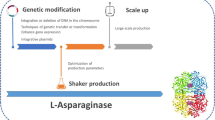Abstract
Glutathione (γ-glutamyl-L-cysteinylglycine, GSH) is a pharmaceutical compound often used in food additives and the cosmetics industry. GSH can be produced biologically from L-glutamic acid, L-cysteine, and glycine through an enzymatic process traditionally involving two sequential adenosine triphosphate (ATP)-dependent reactions catalyzed by γ-glutamylcysteine synthetase (γ-GCS or GSHI, EC 6.3.2.2) and GSH synthetase (GS or GSHII, EC 6.3.2.3). Here, we report the enzymatic production of GSH by recombinant cell-free bifunctional γ-glutamylcysteine synthetase/glutathione synthetase (γ-GCS-GS or GshF) coupled with in vitro acetate kinase-based ATP generation. GSH production by an acetate kinase-integrated Escherichia coli Rosetta(DE3) mutant expressing Streptococcus thermophilus GshF reached 18.3 ± 0.1 g l−1 (59.5 ± 0.3 mM) within 3 h, with a molar yield of 0.75 ± 0.00 mol mol−1 added cysteine and a productivity of 6.1 ± 0.0 g l−1 h−1. This is the highest GSH titer reported to date. This newly developed biocatalytic process offers a promising approach for meeting the industrial requirements for GSH production.



Similar content being viewed by others
References
Carmel-Harel, O., & Storz, G. (2000). Roles of the glutathione- and thioredoxin-dependent reduction systems in the Escherichia coli and Saccharomyces cerevisiae responses to oxidative stress. Annual Review of Microbiology, 54, 439–461.
Datsenko, K. A., & Wanner, B. L. (2000). One-step inactivation of chromosomal genes in Escherichia coli K-12 using PCR products. Proceedings of the National Academy of Sciences of the United States of America, 97, 6640–6645.
Ishii, S., & Miyajima, R. (1989). Glutathione manufacture by cultivation of Saccharomyces in a synthetic medium. Jpn. Patent, 1, 141–591.
Janowiak, B. E., & Griffith, O. W. (2005). Glutathione synthesis in Streptococcus agalactiae. One protein accounts for gamma-glutamylcysteine synthetase and glutathione synthetase activities. The Journal of Biological Chemistry, 280, 11829–11839.
Jiang, Y., Chen, B., Duan, C., Sun, B., Yang, J., & Yang, S. (2015). Multigene editing in the Escherichia coli genome via the CRISPR-Cas9 system. Applied and Environmental Microbiology, 81, 2506–2514.
Kameda, A., Shiba, T., Kawazoe, Y., Satoh, Y., Ihara, Y., Munekata, M., Ishige, K., & Noguchi, T. (2001). A novel ATP regeneration system using polyphosphate-AMP phosphotransferase and polyphosphate kinase. Journal of Bioscience and Bioengineering, 91, 557–563.
Knorr, R., Ehrmann, M. A., & Vogel, R. F. (2001). Cloning, expression, and characterization of acetate kinase from Lactobacillus sanfranciscensis. Microbiological Research, 156, 267–277.
Kuroda, A., & Kornberg, A. (1997). Polyphosphate kinase as a nucleoside diphosphate kinase in Escherichia coli and Pseudomonas aeruginosa. Proceedings of the National Academy of Sciences of the United States of America, 94, 439–442.
Li, W., Li, Z., Yang, J., & Ye, Q. (2011). Production of glutathione using a bifunctional enzyme encoded by gshF from Streptococcus thermophilus expressed in Escherichia coli. Journal of Biotechnology, 154, 261–268.
Li, Y., Wei, G., & Chen, J. (2004). Glutathione: a review on biotechnological production. Applied Microbiology and Biotechnology, 66, 233–242.
Liedschulte, V., Wachter, A., Zhigang, A., & Rausch, T. (2010). Exploiting plants for glutathione (GSH) production: uncoupling GSH synthesis from cellular controls results in unprecedented GSH accumulation. Plant Biotechnology Journal, 8, 807–820.
Matsuyama A, Hideko O., Kitao S. (1994) Novel recombinant DNA and method for production of physiologically active substance. Patent EP387067B1.
Meister, A., & Anderson, M. E. (1983). Glutathione. Annual Review of Biochemistry, 52, 711–760.
Misra, I., & Griffith, O. W. (1998). Expression and purification of human gamma-glutamylcysteine synthetase. Protein Expression and Purification, 13, 268–276.
Murata, K., Tani, K., Kato, J., & Chibata, I. (1980). Continuous production of glutathione using immobilized microbial cells containing ATP generating system. Biochimie, 62, 347–352.
Penninckx, M. J., & Elskens, M. T. (1993). Metabolism and functions of glutathione in micro-organisms. Advances in Microbial Physiology, 34, 239–301.
Richman, P. G., & Meister, A. (1975). Regulation of gamma-glutamyl-cysteine synthetase by nonallosteric feedback inhibition by glutathione. The Journal of Biological Chemistry, 250, 1422–1426.
Sato, M., Masuda, Y., Kirimura, K., & Kino, K. (2007). Thermostable ATP regeneration system using polyphosphate kinase from Thermosynechococcus elongatus BP-1 for D-amino acid dipeptide synthesis. Journal of Bioscience and Bioengineering, 103, 179–184.
Tao, R., Jiang, Y., Zhu, F., & Yang, S. (2014). A one-pot system for production of L-2-aminobutyric acid from L-threonine by L-threonine deaminase and a NADH-regeneration system based on L-leucine dehydrogenase and formate dehydrogenase. Biotechnology Letters, 36, 835–841.
Zhu, L., Tao, R., Wang, Y., Jiang, Y., Lin, X., Yang, Y., Zheng, H., Jiang, W., & Yang, S. (2011). Removal of L-alanine from the production of L-2-aminobutyric acid by introduction of alanine racemase and D-amino acid oxidase. Applied Microbiology and Biotechnology, 90, 903–910.
Author information
Authors and Affiliations
Corresponding author
Ethics declarations
Funding
This work was supported by the National Basic Research Program of China (973: 2014CB745101), Knowledge Innovation Program (KSZD-EW-Z-019), and Science and Technology Service Network Initiative (KFJ-EW-STS-030) of the Chinese Academy of Sciences, and Shanghai Scientific research project (14XD1424900).
Electronic Supplementary Material
ESM 1
(PDF 441 kb)
Rights and permissions
About this article
Cite this article
Jiang, Y., Tao, R., Shen, Z. et al. Enzymatic Production of Glutathione by Bifunctional γ-Glutamylcysteine Synthetase/Glutathione Synthetase Coupled with In Vitro Acetate Kinase-Based ATP Generation. Appl Biochem Biotechnol 180, 1446–1455 (2016). https://doi.org/10.1007/s12010-016-2178-5
Received:
Accepted:
Published:
Issue Date:
DOI: https://doi.org/10.1007/s12010-016-2178-5




